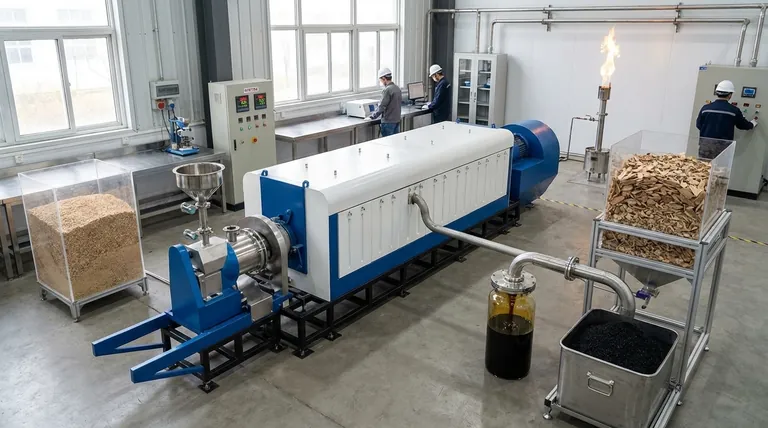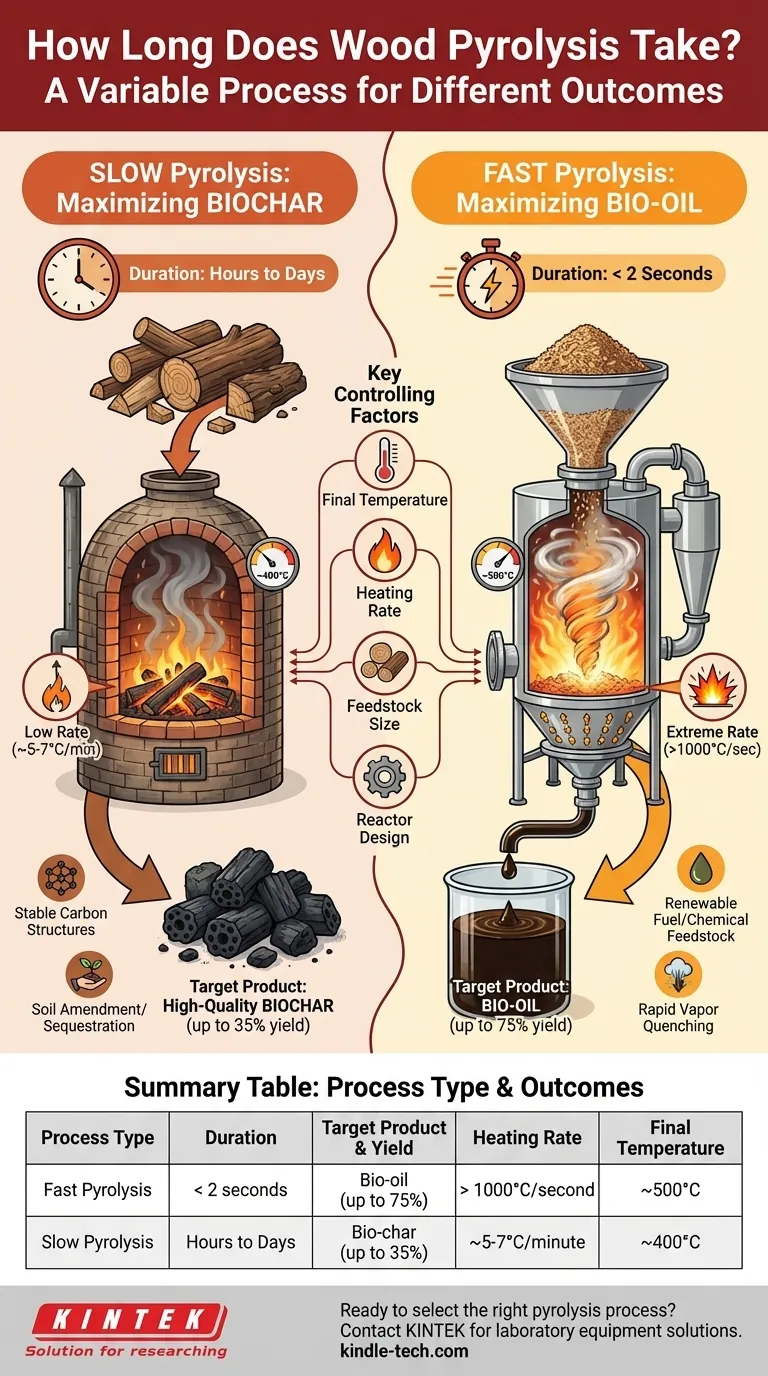The time required for wood pyrolysis is not a single number. It is a highly variable process that can last anywhere from less than a second to several days, depending entirely on the desired outcome. The duration is dictated by the heating rate and final temperature, which are intentionally controlled to optimize the yield of a specific product: biochar, bio-oil, or syngas.
The duration of wood pyrolysis is a deliberate choice, not a fixed constant. Fast processes, lasting mere seconds, are designed to maximize liquid bio-oil, while slow processes, taking hours or days, are used to produce high-quality solid biochar.

The Two Speeds of Pyrolysis: Fast vs. Slow
The primary factor determining the duration of pyrolysis is the rate at which the wood is heated in an oxygen-free environment. This gives rise to two distinct operational modes: fast and slow pyrolysis.
Slow Pyrolysis: Maximizing Biochar
Slow pyrolysis involves heating wood feedstock at a low temperature (around 400°C) over a long period, typically ranging from several hours to days.
The gradual heating rate allows the complex polymers in the wood, like cellulose and lignin, to decompose and rearrange into stable, carbon-rich structures.
This process is optimized to produce the highest possible yield of biochar, a solid material similar to charcoal, while minimizing the production of liquids and gases.
Fast Pyrolysis: Maximizing Bio-oil
Fast pyrolysis is the opposite. Wood feedstock is heated to high temperatures (around 500°C) at an extremely rapid rate.
The entire reaction occurs in less than two seconds. The wood vaporizes almost instantly, and these vapors are then rapidly cooled, or "quenched," to condense them into a liquid.
This process is designed to maximize the yield of bio-oil (also called pyrolysis oil), a dark, viscous liquid that can be used as a renewable fuel or a source for bio-based chemicals.
Key Factors Controlling Pyrolysis Duration
Beyond the fundamental choice between fast and slow methods, several interconnected variables control the precise timing of the reaction.
Heating Rate
This is the most critical control parameter. Slow pyrolysis uses very low heating rates (e.g., 5-7°C per minute), while fast pyrolysis requires extremely high rates (over 1000°C per second).
Final Temperature
Higher peak temperatures are typically used in fast pyrolysis to ensure the rapid and complete vaporization of the feedstock. Slower processes can operate effectively at lower peak temperatures.
Feedstock Size
Heat takes time to penetrate solid wood. Therefore, slow pyrolysis can use larger chunks or logs. Fast pyrolysis requires the feedstock to be finely ground into small particles to ensure it heats up almost instantly.
Reactor Design
The equipment itself is engineered for a specific speed. A simple drum kiln or retort is used for slow pyrolysis, allowing for long residence times. In contrast, reactors like fluidized beds are used for fast pyrolysis to enable rapid heat transfer to small particles.
Understanding the Trade-offs
Choosing between a fast or slow process involves significant trade-offs in equipment, energy, and final product.
Product Yield
The most obvious trade-off is in the output. Slow pyrolysis can yield over 35% biochar by weight, while fast pyrolysis might only yield 12% biochar but can produce up to 75% bio-oil.
Equipment Complexity
Slow pyrolysis systems are generally simpler, more robust, and less expensive to build and operate. Fast pyrolysis reactors require sophisticated engineering to handle precise temperature control, rapid heating, and vapor quenching, making them more complex and costly.
Feedstock Preparation
Slow pyrolysis is more tolerant of varied feedstock sizes and moisture content. Fast pyrolysis demands that the wood be thoroughly dried and ground to a consistent, fine particle size, adding an extra energy-intensive step to the process.
Matching the Process to Your Goal
The correct pyrolysis duration is the one that produces the end product you need most efficiently.
- If your primary focus is creating high-quality biochar for soil amendment or carbon sequestration: Slow pyrolysis, taking hours or days, is the correct approach.
- If your primary focus is producing liquid bio-oil as a renewable fuel or chemical feedstock: Fast pyrolysis, completed in under two seconds, is the necessary method.
- If your primary focus is a balanced output for small-scale, localized energy and soil use: Intermediate pyrolysis, operating on a scale of minutes to an hour, may offer a practical compromise.
Ultimately, the duration of wood pyrolysis is not a limitation but a critical control parameter you can leverage to create the exact product you need.
Summary Table:
| Process Type | Duration | Target Product | Heating Rate | Final Temperature |
|---|---|---|---|---|
| Fast Pyrolysis | < 2 seconds | Bio-oil (up to 75% yield) | > 1000°C/second | ~500°C |
| Slow Pyrolysis | Hours to Days | Bio-char (up to 35% yield) | ~5-7°C/minute | ~400°C |
Ready to select the right pyrolysis process for your biofuel or biochar production goals? The expert team at KINTEK specializes in designing and supplying robust laboratory equipment for pyrolysis research and process optimization. Whether you're scaling up fast pyrolysis for bio-oil or developing a controlled slow pyrolysis system for high-quality biochar, we can provide the reliable reactors and consumables you need. Contact us today via our form to discuss how our solutions can enhance your biomass conversion efficiency and yield.
Visual Guide

Related Products
- Electric Rotary Kiln Small Rotary Furnace Biomass Pyrolysis Plant
- Electric Rotary Kiln Continuous Working Small Rotary Furnace Heating Pyrolysis Plant
- 1200℃ Split Tube Furnace with Quartz Tube Laboratory Tubular Furnace
- Vacuum Sealed Continuous Working Rotary Tube Furnace Rotating Tube Furnace
- Laboratory Sterilizer Lab Autoclave Vertical Pressure Steam Sterilizer for Liquid Crystal Display Automatic Type
People Also Ask
- What is the process of biomass fast pyrolysis? Turn Biomass into Bio-Oil in Seconds
- What are the different types of pyrolysis machines? Choose the Right System for Your Output
- What is a disadvantage of biomass energy? The Hidden Environmental and Economic Costs
- How is energy converted into biomass? Harnessing Nature's Solar Power for Renewable Energy
- What are the conditions for biomass pyrolysis? Optimize Temperature, Heating Rate & Time



















